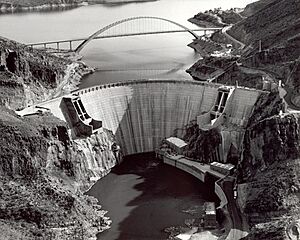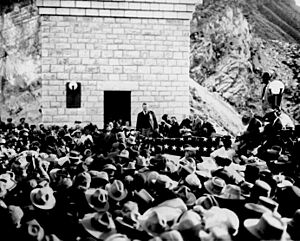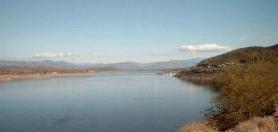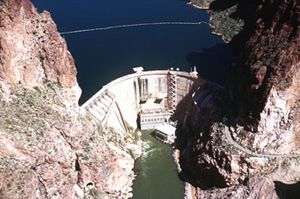Salt River Project facts for kids
 |
|
| Association: Utility cooperative District: Government-owned corporation |
|
| Industry | Public utility |
| Founded | February 7, 1903 |
| Headquarters | Tempe, Arizona, United States |
| Products | Electricity Water |
| Revenue | |
|
Operating income
|
|
|
Number of employees
|
5,123 (FY2023) |
The Salt River Project (SRP) is a big company in Arizona that does two main things. It provides electricity to homes and businesses in the Phoenix metropolitan area. It also supplies water to a large part of central Arizona. Think of it as one of the most important companies for water and power in the state.
SRP is not connected to the Rio Salado Project. That project is about improving the Salt River area in Phoenix.
Contents
What SRP Does: Water and Power
SRP helps bring water and electricity to many people. It serves a large part of the Phoenix area. This means it helps power homes, schools, and businesses. It also makes sure there's enough water for drinking and farming.
How SRP is Managed
SRP is actually made of two separate groups. Each group has its own leaders. These leaders are chosen by landowners in the SRP service area. Elections for these leaders happen every two years in April.
- For the Water Users' Association, landowners choose a president, a vice president, 10 board members, and 30 council members.
- For the Power District, landowners choose a president, a vice president, 14 board members, and 30 council members.
The Story of SRP: A Look Back
The history of SRP is very interesting. It goes back a long time.
Ancient Canals and Early Settlers
Long ago, the Hohokam people lived in this area. They were the ancestors of today's Salt River Pima-Maricopa and Gila River Indian communities. They built many miles of canals to move water. The SRP canal system today follows many of these ancient paths.
Later, settlers came to Phoenix. They needed water for their farms. But the Salt River was tricky. Sometimes it flooded, and sometimes it dried up. This made it hard to farm. People realized they needed a way to control the river.
Building Dams and Forming SRP
In 1902, a new law called the National Reclamation Act of 1902 was passed. This law helped fund big water projects with government loans. Because of this, the Salt River Valley Water Users' Association was formed in 1903. Farmers and ranchers promised their land as a guarantee for the loans. This made it the first big project under the new law.
Soon after, in 1904, construction began on the Roosevelt Dam. This was a huge step!
Besides building dams, SRP also worked on a system of canals. These canals were important for moving water from the Salt River to all the farms in the valley.
Electricity Comes to Phoenix
While the dam was being built, electricity was made there. This power was used to help build the dam. By 1906, even before the dam was fully finished, electricity was being generated from a hydroelectric plant inside the dam. This electricity was sold to power the growing city of Phoenix.
In 1936, the Salt River Project Agricultural Improvement and Power District was created. This was the second part of SRP. Over the years, more dams were built on the Salt and Verde rivers. This brought the total number of reservoirs to six. SRP also built many power plants across the state.
Today, SRP owns or runs eleven power plants. It also has seven hydroelectric plants. It even buys power from four big hydroelectric stations on the Colorado River. This makes SRP a major provider of electricity in the Phoenix area. Along with the six reservoirs, SRP also manages other dams and canals. This makes SRP a key provider of water for Phoenix.
SRP's Reservoirs: Water Storage and Fun
SRP owns and runs four large lakes on the Salt River, east of Phoenix. These lakes store water for the Phoenix area. They can hold a lot of water, over 3 billion gallons!
These lakes are also popular places for fun. People go fishing, boating, and enjoy other water sports there.
Theodore Roosevelt Lake
The Theodore Roosevelt Dam and the Roosevelt Lake it creates are very important to SRP. Building started in 1903. When it was finished in 1911, Roosevelt Dam was the tallest stone dam in the world. It was named after U.S. President Theodore Roosevelt, who dedicated it.
In 1996, the dam was made even bigger. It was covered with concrete and made 77 feet taller. This made the lake's capacity grow by over 20%. It also helped control floods on the Salt River. Roosevelt Lake is the largest lake completely inside Arizona. It can hold a huge amount of water.
Apache Lake
Apache Lake was formed by the Horse Mesa Dam, which was finished in 1927. This dam is 300 feet tall. Apache Lake is smaller than Roosevelt Lake. It is long and narrow, fitting into the canyon. It also has a power station that makes electricity from water.
Canyon Lake
Canyon Lake is the third lake on the Salt River. It was created by the Mormon Flat Dam, finished in 1925. This dam was the second one completed. Canyon Lake is smaller than Apache Lake. Like the other Salt River dams, it has machines that make electricity from water.
Saguaro Lake
Saguaro Lake is formed by the Stewart Mountain Dam. This dam was finished in 1930. It was the last of the big lakes built on the Salt River. Saguaro Lake is a bit larger than Canyon Lake. This dam also has machines that make electricity.
Verde River Reservoirs and Other Dams
After building dams on the Salt River, SRP also worked on the smaller Verde River. The Verde River lakes are also used for water storage, flood control, and fun activities.
Bartlett Lake
The first lake on the Verde River was created by the Bartlett Dam, finished in 1939. This dam is 308.5 feet tall. Bartlett Lake is larger than most of the Salt River lakes, except for Roosevelt. It can hold a lot of water.
Horseshoe Lake
Horseshoe Lake was formed by Horseshoe Dam and finished in 1946. It is upstream from Bartlett Lake. This dam does not make electricity. Horseshoe Lake is slightly larger than Bartlett Lake in surface area.
C.C. Cragin Dam and Reservoir
The C.C. Cragin Dam (formerly Blue Ridge Dam) was built in 1965. SRP took over this dam and its water facilities in 2005. It's not on the Salt or Verde rivers. This small lake helps provide water for the Gila River Indian Community and other areas.
Granite Reef Dam
The Granite Reef Diversion Dam was built in 1906. It's near where the Salt and Verde rivers meet. This dam doesn't hold back a big lake. Instead, it helps direct water from the rivers into the canal system that goes to Phoenix. It was the first dam built by SRP.
SRP's Canal System
SRP runs a network of canals throughout the southern part of the Phoenix area. These canals move water from the Salt River system to where it's needed. Some of the main canals are:
- Arizona Canal, which is 38.62 miles long.
- Grand Canal, 22.43 miles long.
- Consolidated Canal, 18.95 miles long.
- Eastern Canal, 14.73 miles long.
- Western Canal, 13.61 miles long.
- South Canal, 9.91 miles long.
- Tempe Canal, 9.76 miles long.
- New Crosscut Canal, 3.4 miles long.
SRP also manages canals that help control floods in the Phoenix area.
How SRP Makes Power
Besides the power made at the dams, SRP also owns or helps run several power plants across Arizona. These plants generate electricity for the region. Some of them include:
- Agua Fria Generating Station
- Coolidge Generating Station
- Coronado Generating Station
- Craig Generating Station
- Desert Basin Generating Station
- Four Corners Generating Station (SRP owns 10%)
- Gila River Generating Station
- Hayden Generating Station
- Kyrene Generating Station
- Mesquite Generating Station
- Navajo Generating Station (SRP owned 42.9% until it stopped making power in November 2019)
- Palo Verde Nuclear Generating Station (SRP owns 20.2%)
- Santan Generating Station
- Arizona Falls
SRP and Other Groups
SRP works with many other organizations. For example, it is a member of the Electric Power Research Institute (EPRI), which does research on electricity. It is also part of the American Public Power Association (APPA), which represents public power companies.






